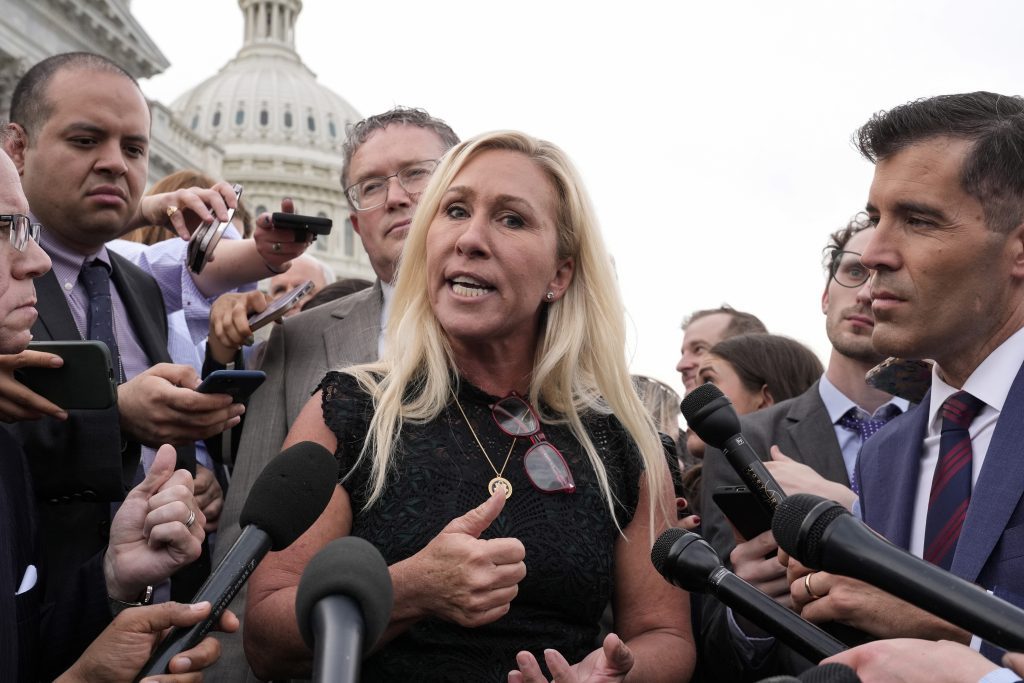The House voted 359-43-7 to dismiss Greene's motion, preventing it from being considered.
The chamber voted 359-43-7 on a motion to table, or dismiss, Greene’s motion-to-vacate resolution, preventing the removal proposal from being considered.
In an unusual move, 163 Democrats and 11 conservative Republicans supported keeping Johnson in power, demonstrating rare unity in the deeply divided House. 11 conservative Republicans voted to send Greene’s motion to the floor. The chamber erupted in boos on both sides of the aisle when Greene began reading her resolution.
The result was not unexpected.
Democratic leaders had announced their intention to protect Johnson from Greene's removal attempt, delivering a significant blow to Greene's standing within the GOP.
Highlighting that division, Trump on Wednesday praised Greene’s “spirit” but urged GOP lawmakers to vote to sink her resolution to unite against Democrats in a statement posted minutes after the vote had already taken place.
“[I]f we show DISUNITY, which will be portrayed as CHAOS, it will negatively affect everything!” Trump wrote on his Truth Social platform. “Mike Johnson is a good man who is trying very hard.”
The vote means Johnson will remain as the Speaker for now, despite the internal conflict within the GOP.
But the vote puts him in the precarious position of being a GOP Speaker propped up by Democrats, which could earn him the ire of conservatives who have already forecast that he won’t lead the party in the next Congress.
In brief remarks delivered shortly after Wednesday’s vote, Johnson thanked his colleagues for their support.
“I appreciate the show of confidence from my colleagues to defeat this misguided effort,” he said. “That is certainly what it was.”
“As I’ve said from the beginning and I’ve made clear every day, I intend to do my job. I intend to do what I believe to be the right thing, which is what I was elected to do, and I’ll let the chips fall where they may,” he continued. “In my view, that is leadership.”
The vote came after Greene and Rep. Thomas Massie (R-Ky.) met with the Speaker to demand changes to his leadership approach, seeking assurances about legislation and funding for Ukraine.
On Tuesday, Greene said that it was up to Johnson to respond to those demands. Her move on Wednesday to push for a vote on his removal shows that he rejected them.
“We attempted to work with the Speaker and when it became very clear yesterday that he wasn’t actually going to put these things into action, that was it,” she said. “It was like why are we going to keep prolonging this? And so we chose to call the vote today.”
More than a month ago, Greene filed her initial motion-to-vacate resolution after Johnson had supported legislation to fund the federal government through September. But she escalated the threat on Wednesday afternoon by pushing the proposal to the floor for consideration, which surprised many lawmakers in both parties after it seemed that the Georgia Republican was backing off her threat.
“Everything that we had heard was that this wasn’t happening,” said Rep. Austin Scott (R-Ga.). “I’m a little surprised, to be honest with you, that it is.”
But the removal resolution had a very short lifespan. House Majority Leader Steve Scalise (R-La.) immediately proposed to table the measure, setting up the vote that killed it with vast Democratic support.
These dynamics contrasted sharply with the successful vote to remove McCarthy in October, which Democrats unanimously supported. But Democrats emphasized that their votes were not an endorsement of Johnson’s conservative track record, which includes efforts to ban abortion and deny gay rights, but reflected his willingness to cut bipartisan deals on significant legislation — and their desire to deny Greene a victory.
“Our decision to prevent Marjorie Taylor Greene from plunging the House of Representatives and the country into further chaos is rooted in our commitment to address issues for everyday Americans in a bipartisan manner,” House Minority Leader Hakeem Jeffries (D-N.Y.) said after the vote. “We need more practicality and less chaos in Washington, D.C.”
The vote concluded a weeks-long saga over when — and at times, if — Greene would move to remove Johnson, which had become a kind of guessing game on Capitol Hill.
In March, Greene filed her motion to vacate as the House was voting on a wide-reaching government funding bill, which the Georgia Republican opposed. The firebrand’s anger with Johnson became more evident after he supported a measure to reauthorize the U.S.’s warrantless surveillance powers. And it reached a boiling point last month when the Speaker forced through a foreign aid package that included billions of dollars in aid for Ukraine.
Those frustrations led Greene last week to vow to force a vote on Johnson’s removal this week, setting a deadline on the highly anticipated move after weeks of indecision.
But when she returned to Washington this week, Greene asked for a meeting with Johnson and met with him in his office for hours on Monday and Tuesday, leading many to believe that she may be pulling back on her very public ploy.
At the last minute, Greene made a series of demands of Johnson as a final offramp for the removal vote, including only bringing bills to the floor that have support from a majority of the GOP conference, a practice known as the Hastert rule, committing to not passing any additional aid for Ukraine; defunding special counsels, including Jack Smith, who is investigating former President Trump; and imposing a 1-percent spending cut across the board if Congress does not complete its regular appropriations process by Sept. 30.
When the Speaker refused to comply with the requests — he insisted that his discussions with Greene were not a negotiation — the Georgia Republican said she chose to move forward.
“We won't have a House majority if we keep Mike Johnson,” she cautioned last week when promising to bring her motion to the floor.









